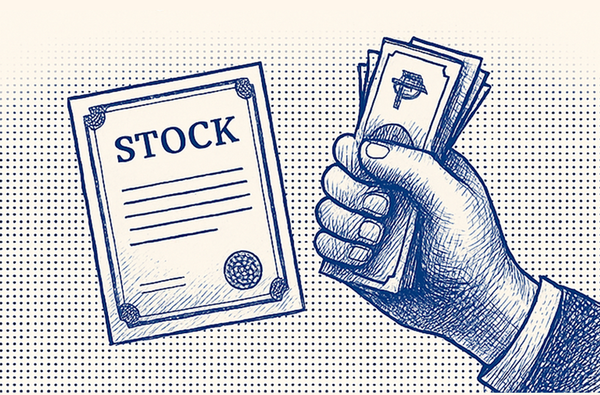A Simple Valuation Technique From a Superinvestor Who Beat Warren Buffett's Track Record
Peter Lynch averaged an annual return of 29% per year, beating Warren Buffett's average of around 20% per year. Today we'll cover a simple valuation technique Lynch taught

Before reading this article, make sure you've already read these two:
- How to Value Your First Stock In 1 Hour or Less – No Finance Knowledge Required!
- How to Estimate A Company’s Future Growth
I'll assume you have background knowledge on PE ratios and growth calculations.
Peter Lynch averaged an annual return of 29% per year during his career as the manager of the Fidelity Magellan Fund, beating Warren Buffett's career average of around 20% per year.
Today we'll cover a simple valuation technique Lynch taught in his book, "One Up on Wall Street".
What do P/E ratios have to do with growth rates?
As you know, P/E ratios are a general measure of how "cheap" a stock is.
Remember: P/E equals Price divided by Earnings or Income. The lower your P/E ratio is, the less you're paying per unit of earnings.
One downside of relying on P/E ratios is that they ignore TON of information. A slowly sinking company deserves to be cheap. A company with amazing prospects deserves to be expensive. P/E ratios alone can't tell you if a company is a worthwhile investment.
What's a metric we can use to assess a company's health? Its probable growth rate.
By analyzing a company's P/E ratio alongside its growth rate, we can assess how cheap a company is relative to its financial and operational strength.
To do this, we can use the "Price/Earnings-to-Growth Ratio", commonly known as the "PEG Ratio"
The PEG Ratio
Here's the formula for the PEG ratio:
PEG = (P/E Ratio) / (Expected Long-Term Growth Rate)
A low PEG ratio means that the company is cheap, while a high PEG ratio means that the company is expensive.
Here's an example showing why PEG ratios can be better than P/E ratios:
Let's say you have two companies:
- Company A:
- P/E Ratio: 3
- Expected Growth Rate: 2% per year
- Company B:
- P/E Ratio: 20
- Expected Growth Rate: 30% per year
If we were to use a standard P/E ratio comparison, Company A would come out as the winner - it LOOKS cheaper with a P/E ratio of 3, compared to Company B, which has a ratio of 20.
However, in this scenario, this basic P/E ratio analysis is a trap. While Company A does have a lower P/E ratio, it also has a pathetic growth rate of 2% per year.
If we were to compare PEG ratios instead, we would get the following:
- Company A:
- PEG = P/E divided by Growth
- PEG = 3/2
- PEG = 1.5
- Company B:
- PEG = P/E divided by Growth
- PEG = 20/30
- PEG = 0.66
Company B has the lower PEG ratio, making it a better purchase! While Company A had a lower P/E ratio, it deserved to be priced cheap compared to Company B, which had the growth to back up its higher P/E ratio.
The problem with comparison-based valuations
One problem with the PEG analysis above is that it requires comparison among companies.
Valuation techniques that rely on comparisons are great for beginners because they're easy. However, comparisons can turn into traps when the entire group of companies is expensive.
Sure, Company B can be cheaper than Company A. But what if the entire group of companies are expensive? Then you'd still end up with an overpriced company.
The cheapest among the expensive is still expensive.
A solid valuation technique must not rely on comparisons among multiple companies.
In his book "One Up On Wall Street", Peter Lynch described a simple method for valuing companies in isolation using their PEG ratio.
The Peter Lynch PEG Ratio Valuation
Here's the incredibly simple rule of thumb Peter Lynch taught:
The fair value of a company is whatever price will make its PEG ratio = 1.
If we insert this into the PEG formula, we can solve for what Price in the P/E ratio SHOULD be assuming the PEG is equal to 1:
PEG = 1
(Price / Earnings ) / Growth = 1
Price / Earnings = Growth
Price = Growth x Earnings
Therefore:
Fair Value Per Share = (Expected Growth Rate) x (Earnings Per Share)
Applying the Technique
Let's apply this formula in an example.
We know the following about Company X:
- Earnings Per Share = 10
- Expected Long-Term Growth Rate = 20%
- It is selling for 150 per share
If you want to learn how to estimate growth rates, click here.
To get the fair value of the company, we solve for what price should be if Company X's PEG ratio is equal to 1:
PEG = 1
(Price / Earnings ) / Growth = 1
(Price / 10 ) / 20 = 1
Price = 20 x 10
Price = 200
According to this valuation technique, the fair value of Company X is 200 per share. If it's currently priced at 150 per share, you'll need to decide for yourself whether a 25% discount is worth the buy.
Conclusion
Peter Lynch's PEG valuation technique isn't perfect. You can get the growth projections wrong, and growth is just one metric for judging a company's health. The technique is meant to be used for ballparking, not extreme precision.
However, it's an easy technique to learn that doesn't rely on comparison and current prices.
Try using it on stocks you're eyeing to buy. It could save you from expensive purchases and help you identify deep discounts.



